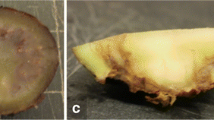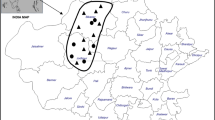Abstract
The main causative agents of Fusarium head blight in central Europe are Fusarium graminearum and F. culmorum. We examined the mycotoxin producing ability, aggressiveness and molecular variability of F. graminearum isolates. Altogether twenty-six Hungarian, three Austrian isolates and representatives of eight species identified in the F. graminearum species complex were involved in this study. Mycotoxin producing abilities of the isolates were tested by GC-MS and HPLC. The central European isolates were found to belong to chemotype I (producing deoxynivalenol). Most isolates produced more 15-acetyl-deoxynivalenol than 3-acetyl-deoxynivalenol suggesting that they belong to chemotype Ib. All F. graminearum isolates were found to be highly pathogenic in in vitro aggressiveness tests. Phylogenetic analysis of random amplified polymorphic DNA profiles, and restriction profiles of the intergenic spacer region of the ribosomal RNA gene cluster of the isolates allowed clustering of the central European isolates into 17 and 16 haplotypes, respectively. When RAPD and IGS-RFLP data were combined, almost every single central European F. graminearum isolate could be differentiated (27/29 haplotypes). Sequence analysis of a putative reductase gene of some isolates was also performed. Based on molecular data, the majority of the central European isolates belonged to F. graminearum sensu stricto characteristic to the northern hemisphere, with the exception of one Hungarian isolate, which was not related to any known species of the F. graminearum species complex based on sequence data. The taxonomic assignment of two other Hungarian isolates, previously suggested as belonging to F. boothii based on mitochondrial DNA restriction profiles, was supported by sequence analysis.
Similar content being viewed by others
References
BJ Blaney RL Dodman (2002) ArticleTitleProduction of zearalenone, deoxynivalenol, nivalenol, and acetylated derivatives by Australian isolates of F. graminearum and F. pseudograminearum in relation to source and culturing conditions Australian Journal of Agricultural Research 53 1317–1326 Occurrence Handle1:CAS:528:DC%2BD3sXhtVShur8%3D
LE Broggi GA Molto (2001) ArticleTitleFungi associated with rice at Entre Rios province, Argentina. Toxigenic capacity of Fusarium graminearum and Microdochium nivale isolates Mycotoxin Research 17 96–107 Occurrence Handle1:CAS:528:DC%2BD38XptVKgt7k%3D
JB Buntjer (1997) Phylogenetic computer tools (PhylTools). Version 1.32 for Windows Laboratory of Plant Breeding, Wageningen University The Netherlands
JP Carter HN Rezanoor D Holden AE Desjardins RD Plattner P Nicholson (2002) ArticleTitleVariation in pathogenicity associated with the genetic diversity of Fusarium graminearum European Journal of Plant Pathology 108 573–583 Occurrence Handle10.1023/A:1019921203161 Occurrence Handle1:CAS:528:DC%2BD38Xms1eks7c%3D
AE Desjardins AM Jarosz RD Plattner NJ Alexander DW Brown JE Jurgenson (2004) ArticleTitlePatterns of trichothecene production, genetic variability, and virulence to wheat of Fusarium graminearum from smallholder farms in Nepal Journal of Agricultural and Food Chemistry 52 6341–6346 Occurrence Handle10.1021/jf040181e Occurrence Handle15453711 Occurrence Handle1:CAS:528:DC%2BD2cXntVehs7c%3D
M Dusabenyagasani D Dostaler RC Hamelin (1999) ArticleTitleGenetic diversity among Fusarium graminearum strains from Ontario and Quebec Canadian Journal of Plant Pathology 21 308–314 Occurrence Handle10.1080/07060669909501196
FJS Eudes J Collin S Rioux A Comeau (1997) ArticleTitleThe trichothecenes, a major component of wheat pathogenesis Cereal Research Communications 25 495–496 Occurrence Handle1:CAS:528:DyaK1cXjs1Wg
J Felsenstein (1985) ArticleTitleConfidence limits on phylogenies: an approach using the bootstrap Evolution 39 783–791
J Felsenstein (1995) PHYLIP (Phylogeny Inference Package) Version 3.57c Department of Genetics, University of Washington Seattle
Fernando WGD, Ramarathnam J, Gilbert J and Clear R (2003) Genetic diversity of Fusarium graminearum Isolates from wheat, barley, and corn. In: Proceedings of International Congress of Plant Pathology 2–8 February 2003, New Zealand (pp. 107–112).
TY Gagkaeva T Yli-Mattila (2004) ArticleTitleGenetic diversity of Fusarium graminearum in Europe and Asia European Journal of Plant Pathology 110 550–562 Occurrence Handle10.1023/B:EJPP.0000032395.11246.d0
LR Gale LF Chen CA Hernick K Takamura HC Kistler (2002) ArticleTitlePopulation analysis of Fusarium graminearum from wheat fields in eastern China Phytopathology 92 1315–1322 Occurrence Handle1:CAS:528:DC%2BD38XpsV2rsbo%3D Occurrence Handle18943886
Gale LR, Ward TJ, Balmas V and Kistler HC, (2003) Detection of distinct subpopulations of Fusarium graminearum lineage 7 in the US. 2003 National Fusarium Head Blight Forum Proceedings, p. 139.
RS Goswami HC Kistler (2004) ArticleTitleHeading for disaster: Fusarium graminearum on cereal crops Molecular Plant Pathology 5 515–525 Occurrence Handle10.1111/j.1364-3703.2004.00252.x Occurrence Handle1:CAS:528:DC%2BD2MXit1enug%3D%3D Occurrence Handle20565626
P Jennings ME Coates K Walsh JA Turner P Nicholson (2004) ArticleTitleDetermination of deoxynivalenol- and nivalenol-producing chemotypes of Fusarium graminearum isolated from wheat crops in England and Wales Plant Pathology 53 643–652 Occurrence Handle1:CAS:528:DC%2BD2cXhtVSgtL%2FF
Z Kerényi G Mule C Waalwijk B Oláh L Hornok (2004) ArticleTitleMating type sequences in asexually reproducing Fusarium species Applied and Environmental Microbiology 70 4419–4423 Occurrence Handle15294768
M Kimura (1980) ArticleTitleA simple method for estimating evolutionary rate of base substitutions through comparative studies on nucleotide sequences Journal of Molecular Evolution 2 87–90
M Láday Á Juhász G Mulè A Moretti Á Szécsi A Logrieco (2004) ArticleTitleMitochondrial DNA diversity and lineage determination of European isolates of Fusarium graminearum (Gibberella zeae) European Journal of Plant Pathology 110 545–550
W Langseth M Ghebremeskel B Kosiak P Kolsaker D Miller (2001) ArticleTitleProduction of culmorin compounds and other secondary metabolites by Fusarium culmorum and F. graminearum strains isolated from Norwegian cereals Mycopathologia 152 23–34 Occurrence Handle10.1023/A:1011964306510 Occurrence Handle11694092 Occurrence Handle1:CAS:528:DC%2BD3MXovV2ksrs%3D
DR Lauren ST Sayer ME Di Menna (1992) ArticleTitleTrichothecene production by Fusarium species isolated from grain and pasture throughout New Zealand Mycopathologia 120 167–176 Occurrence Handle10.1007/BF00436395 Occurrence Handle1:CAS:528:DyaK3sXksVGgtLY%3D
J Leach DB Finkelstein JA Rambosek (1986) ArticleTitleRapid miniprep of DNA from filamentous fungi Fungal Genetics Newsletter 33 32–33
Á Mesterházy (1985) ArticleTitleEffect of seed production area on the seedling resistance of wheat to Fusarium seedling blight Agronomie 5 491–497
Á Mesterházy (2002) ArticleTitleRole of deoxynivalenol in aggressiveness of Fusarium graminearum and F. culmorum and in resistance to Fusarium head blight European Journal of Plant Pathology 108 675–684
T Miedaner C Reinbrecht (2001) ArticleTitleTrichothecene content of rye and wheat genotypes inoculated with a deoxynivalenol- and a nivalenol-producing isolate of Fusarium culmorum Journal of Phytopathology 149 245–251 Occurrence Handle1:CAS:528:DC%2BD3MXls1Oju7s%3D
T Miedaner AG Schilling HH Geiger (2001) ArticleTitleMolecular genetic diversity and variation for aggressiveness in populations of Fusarium graminearum and Fusarium culmorum sampled from wheat fields in different countries Journal of Phytopathology 149 641–648 Occurrence Handle1:CAS:528:DC%2BD38XovVGmsw%3D%3D
JD Miller R Greenhalgh YZ Wang M Lu (1991) ArticleTitleTrichothecene chemotypes of three Fusarium species Mycologia 83 121–130 Occurrence Handle1:CAS:528:DyaK38XjslGmtA%3D%3D
PK Mishra RTV Fox A Culham (2002) ArticleTitleRestriction analysis of PCR amplified nrDNA regions revealed intraspecific variation within populations of Fusarium culmorum FEMS Microbiology Letters 215 291–296 Occurrence Handle10.1016/S0378-1097(02)00966-7 Occurrence Handle12399049 Occurrence Handle1:CAS:528:DC%2BD38XotVKqtr0%3D
JH Moon YH Lee YW Lee (1999) ArticleTitleVegetative compatibility groups in Fusarium graminearum isolates from corn and barley in Korea Plant Pathology Journal 15 53–56
K O’Donnell HC Kistler BK Tacke HH Casper (2000) ArticleTitleGene genealogies reveal global phylogeographic structure and reproductive isolation among lineages of Fusarium graminearum, the fungus causing wheat scab Proceedings of the National Academy of Sciences USA 97 7905–7910 Occurrence Handle1:CAS:528:DC%2BD3cXkvFCnuro%3D
K O’Donnell TJ Ward DM Geiser HC Kistler T Aoki (2004) ArticleTitleGenealogical concordance between the mating type locus and seven other nuclear genes supports formal recognition of nine phylogenetically distinct species within the Fusarium graminearum clade Fungal Genetics and Biology 41 600–623 Occurrence Handle15121083 Occurrence Handle1:CAS:528:DC%2BD2cXjs1Cis78%3D
T Ouellet KA Seifert (1993) ArticleTitleGenetic characterization of Fusarium graminearum strains using RAPD and PCR amplification Phytopathology 83 1003–1007 Occurrence Handle1:CAS:528:DyaK2cXhtVWksbk%3D
MS Pineiro PM Scott SR Kanhere (1996) ArticleTitleMycotoxin producing potential of Fusarium graminearum isolates from Uruguayan barley Mycopathologia 132 167–172 Occurrence Handle1:STN:280:DyaK283lsFCrug%3D%3D
RH Proctor AE Desjardins SP McCormick RD Plattner NJ Alexander DW Brown (2002) ArticleTitleGenetic analysis of the role of trichothecene and fumonisin mycotoxins in the virulence of Fusarium European Journal of Plant Pathology 108 691–698 Occurrence Handle10.1023/A:1020637832371 Occurrence Handle1:CAS:528:DC%2BD38XnvVyisLg%3D
E Rinyu J Varga L Ferenczy (1995) ArticleTitlePhenotypic and genotypic analysis of variability in Aspergillus fumigatus Journal of Clinical Microbiology 33 2567–2575 Occurrence Handle8567884 Occurrence Handle1:CAS:528:DyaK2MXptFOmsr0%3D
N Saitou M Nei (1987) ArticleTitleThe neighbor-joining method: a new method for reconstructing phylogenetic trees Molecular Biology and Evolution 4 406–425 Occurrence Handle3447015 Occurrence Handle1:STN:280:DyaL1c7ovFSjsA%3D%3D
CL Schardl KD Craven (2003) ArticleTitleInterspecific hybridization in plant-associated fungi and oomycetes: a review Molecular Ecology 12 2861–2873 Occurrence Handle10.1046/j.1365-294X.2003.01965.x Occurrence Handle14629368 Occurrence Handle1:STN:280:DC%2BD3srltFCitg%3D%3D
Shields E, (1999) Long-range movement of Fusarium graminearum. www.inhs.uiuc.edu/cee/movement/99NY2.html.
Y Sugiura Y Watanabe T Tanaka S Yamamoto Y Ueno (1990) ArticleTitleOccurrence of Gibberella zeae strains that produce both nivalenol and deoxynivalenol Applied and Environmental Microbiology 56 3047–3051 Occurrence Handle2285316 Occurrence Handle1:CAS:528:DyaK3MXitVOjsg%3D%3D
Á Szécsi T Bartók (1995) ArticleTitleTrichothecene chemotypes of Fusarium graminearum isolated from corn in Hungary Mycotoxin Research 11 85–92
JW Taylor DJ Jacobson MC Fisher (1999) ArticleTitleThe evolution of asexual fungi: Reproduction, speciation and classification Annual Review of Phytopathology 37 197–246 Occurrence Handle10.1146/annurev.phyto.37.1.197 Occurrence Handle11701822 Occurrence Handle1:CAS:528:DyaK1MXnt1Wnt78%3D
JD Thompson TJ Gibson F Plewniak F Jeanmougin DG Higgins (1997) ArticleTitleThe CLUSTAL X windows interface: Flexible strategies for multiple sequence alignment aided by quality analysis tools Nucleic Acids Research 25 4876–4882 Occurrence Handle10.1093/nar/25.24.4876 Occurrence Handle9396791 Occurrence Handle1:CAS:528:DyaK1cXntFyntQ%3D%3D
B Tóth Á Mesterházy P Nicholson J Téren J Varga (2004) ArticleTitleMycotoxin production and molecular variability of European and American Fusarium culmorum isolates European Journal of Plant Pathology 110 587–599
J Varga B Tóth Á Mesterházy J Téren B Fazekas (2004) Mycotoxigenic fungi and mycotoxins in foods and feeds in Hungary A Logrieco A Visconti (Eds) An Overview on Toxigenic Fungi and Mycotoxins in Europe Springer-Verlag GmbH London 123–139
SL Walker S Leath Hagler WMJr JP Murphy (2001) ArticleTitleVariation among isolates of Fusarium graminearum associated with Fusarium head blight in North Carolina Plant Disease 85 404–410
TJ Ward JP Bielawski HC Kistler E Sullivan K O’Donnell (2002) ArticleTitleAncestral polymorphism and adaptive evolution in the trichothecene mycotoxin gene cluster of phytopathogenic Fusarium Proceedings of the National Academy of Sciences USA 99 9278–9283 Occurrence Handle1:CAS:528:DC%2BD38XlsVGgsLo%3D
KA Zeller RL Bowden JF Leslie (2003) ArticleTitleDiversity of epidemic populations of Gibberella zeae from small quadrats in Kansas and North Dakota Phytopathology 93 874–880 Occurrence Handle18943169
KA Zeller RL Bowden JF Leslie (2004) ArticleTitlePopulation differentiation and recombination in wheat scab populations of Gibberella zeae from the United States Molecular Ecology 13 563–571 Occurrence Handle10.1046/j.1365-294X.2004.02098.x Occurrence Handle14871361
Author information
Authors and Affiliations
Corresponding author
Rights and permissions
About this article
Cite this article
Tóth, B., Mesterházy, Á., Horváth, Z. et al. Genetic Variability of Central European Isolates of the Fusarium graminearum Species Complex. Eur J Plant Pathol 113, 35–45 (2005). https://doi.org/10.1007/s10658-005-0296-y
Accepted:
Issue Date:
DOI: https://doi.org/10.1007/s10658-005-0296-y




